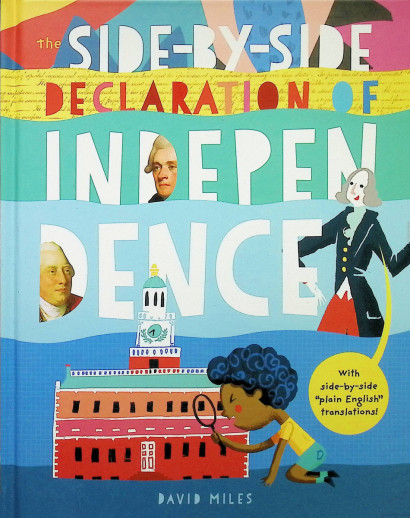We use cookies to make your experience better. To comply with the new e-Privacy directive, we need to ask for your consent to set the cookies. Learn more.
Side-by-Side Declaration of Independence
Primary Source documents can be tough to present in an engaging way to young students. Presented in a side-by-side fashion, students are exposed to the original language of a primary document and a plain English translation on the facing page. Historical and contextual information is presented in bite-sized chunks. Illustrations and photographs are in full-color on brightly decorated pages. Learning aids are scattered throughout the pages that include critical thinking questions, investigation or look closer prompts, and brief history excerpts. Students will gain a richer vocabulary throughout these pages with many vocab words highlighted. Used on its own or with the Notebook Companion (029456) to introduce this foundational document to students! 92 pgs, hc. ~Rebecca
We hold these truths to be self-evident...
Do you know what's actually in the full Declaration of Independence? How it was written? What was happening at the time? How to read the formal language? Don't worry! Because now, in The Side-by-Side Declaration of Independence, kid patriots (and grown-ups alike!) can tackle the Declaration like never before. Decipher the original text of the Declaration on each left-hand page with help from a “plain English” translation on each right-hand page. Bright illustrations, historical explanations, helpful definitions, and other fun facts round out this brilliant introduction to one of the world’s most important documents.
Leading up to, during, or right after an election is a great time to introduce the Declaration of Independance! Daily Skill Building comes alongside factual, informational, engaging texts for kids and turns these reads into an interactive educational experience. The companion Notebook (Understanding the Declaration of Independence) coincides with the spine text to add further understanding and deeper comprehension work while students read. Lessons inside the notebooks include open-ended questions, drawing spaces, writing prompts, vocabulary words, and optional research projects for students who are ready. The Notebook can be geared up or down depending on your students’ capabilities and at the end of their studies they have created their own notebook with all they have learned.
The spine text (Side-by-Side Declaration of Independence) includes topic content and hands-on learning that is presented in bite-sized, understandable chunks. Students will be guided through original texts and provided with a more modern understanding, alongside cultural context. This provides an open-and-go option for busy families as there is no prep work required and the study is self-paced as the student reads. ~Rebecca
| Product Format: | Hardcover |
|---|---|
| Grades: | 4-7 |
| Brand: | Bushel & Peck Books |
| ISBN: | 9781638190486 |
| Length in Inches: | 9.3125 |
| Width in Inches: | 7.3125 |
| Height in Inches: | 0.5625 |
| Weight in Pounds: | 1.1 |
Be the first to review this item


Strong magnet & cute too! Already have one but need one more.